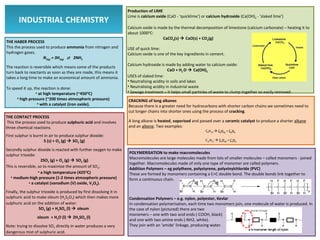
Industrial chemistry
- 1. INDUSTRIAL CHEMISTRYINDUSTRIAL CHEMISTRY THE HABER PROCESS This the process used to produce ammonia from nitrogen and hydrogen gases. N2(g) + 3H2(g) 2NH3 The reaction is reversible which means some of the products turn back to reactants as soon as they are made, this means it takes a long time to make an economical amount of ammonia. To speed it up, the reaction is done: • at high temperature (~450O C) • high pressure (~200 times atmospheric pressure) • with a catalyst (iron oxide). THE CONTACT PROCESS This the process used to produce sulphuric acid and involves three chemical reactions. First sulphur is burnt in air to produce sulphur dioxide: S (s) + O2 (g) SO2 (g) Secondly sulphur dioxide is reacted with further oxygen to make sulphur trioxide: 2SO2 (g) + O2 (g) SO3 (g) This is reversible, so to maximise the amount of SO3: • a high temperature (425O C) • medium-high pressure (1-2 times atmospheric pressure) • a catalyst (vanadium (V) oxide, V2O5). Finally, the sulphur trioxide is produced by first dissolving it in sulphuric acid to make oleum (H2S2O7) which then makes more sulphuric acid on the addition of water: SO3 (g) + H2SO4 (l) oleum oleum + H2O (l) 2H2SO4 (l) Note: trying to dissolve SO3 directly in water produces a very dangerous mist of sulphuric acid. Production of LIME Lime is calcium oxide (CaO - ‘quicklime’) or calcium hydroxide (Ca(OH)2 - ‘slaked lime’) Calcium oxide is made by the thermal decomposition of limestone (calcium carbonate) – heating it to about 1000O C: CaCO3(s) CaO(s) + CO2(g) USE of quick lime: Calcium oxide is one of the key ingredients in cement. Calcium hydroxide is made by adding water to calcium oxide: CaO + H2 O Ca(OH)2 USES of slaked lime: • Neutralising acidity in soils and lakes • Neutralising acidity in industrial waste • Sewage treatment – it helps small particles of waste to clump together so easily removed. CRACKING of long alkanes Because there is a greater need for hydrocarbons with shorter carbon chains we sometimes need to cut longer chains into shorter ones using the process of cracking. A long alkane is heated, vaporised and passed over a ceramic catalyst to produce a shorter alkane and an alkene. Two examples: C8H18 C4H10 + C4H8 C10H22 C7H16 + C3H6 POLYMERISATION to make macromolecules Macromolecules are large molecules made from lots of smaller molecules – called monomers - joined together. Macromolecules made of only one type of monomer are called polymers. Addition Polymers – eg polythene, polystyrene, polyvinylchloride (PVC) These are formed by monomers containing a C=C double bond. The double bonds link together to form a continuous chain. Condensation Polymers – e.g. nylon, polyester, Kevlar In condensation polymerisation, each time two monomers join, one molecule of water is produced. In the case of nylon (pictured) there are two monomers – one with two acid ends (-COOH, black) and one with two amine ends (-NH2, white). They join with an ‘amide’ linkage, producing water.
- 2. EXTRACTION of Iron from Iron Ore using the BLAST FURNACE Iron can be extracted from iron ore (Fe2O3, iron (III) oxide) and lead can be extracted from an ore called galena (PbS, lead sulphide). Metals that are less reactive than carbon can be extracted by using carbon as a reducing agent (to steal the oxygen/sulphur). Metals that are more reactive than carbon must be produced by electrolysis. Iron is less reactive than carbon so can be reduced by it. This is done in a blast furnace. Study the diagram then read the following: Step 1: Carbon (coke) reacts with oxygen (from the hot air blast): C (s)+ O2(g) CO2(g) Step 2: Carbon dioxide reacts with more carbon to make carbon monoxide: CO2(g) + C(s) 2CO(g) Step 3: Carbon monoxide reduces the iron oxide (iron ore) to make molten liquid iron: Fe2O3(s) + CO(g) Fe(l) + CO2(g) Step 1 happens here Step 2 happens here Step 3 happens here PURIFICATION of Copper When copper is made it contains lots of impurities. The copper is purified by electrolysis. A large lump of impure copper is used as the anode, the electrolyte is copper sulphate solution and the cathode is made of pure copper. At the anode, instead of anions losing electrons, neutral copper atoms lose electrons to become copper ions . Cu(s) Cu2+ (aq) + 2e- These then move through the electrolyte to the cathode where they become copper atoms again. Cu2+ (aq) + 2e- Cu(s) The anode loses mass as copper atoms leave it and the cathode gains mass as copper atoms join it. The impurities sink to the bottom as a pile of sludge. EXTRACTION of Aluminium from Bauxite by ELECTROLYSIS Aluminium ore is called bauxite. Impurities are removed to leave aluminium oxide (Al2O3). The aluminium oxide is dissolved in molten cryolite (as it has a lower melting point than aluminium oxide by itself). This is poured into a large carbon lined vessel which acts as the cathode for electrolysis. A large anode made of carbon is lowered into the electrolyte. The processes that take place are: At the cathode: aluminium ions gain electrons to make liquid aluminium Al3+ + 3e- Al(l) At the anode: Oxide ions lose electrons to make oxygen gas 2O2- O2(g) + 2e- The oxygen reacts with the carbon anode to make carbon dioxide, so the anodes have to be